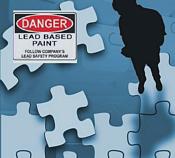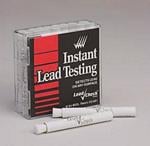A Few Steps in the Right Direction Regarding the RRP Rule
 Legislation introduced by Senator Inhofe (R) will soon be before the US Senate for consideration. Inhofe introduced Bill 2148, the ‘‘Lead Exposure Reduction Amendments Act of 2012’’. As well as several other amendments, the bill seeks to reinstate the RRP Opt Out provision that was previously removed when the Sierra Club sued the EPA back in 2009. Inhofe’s bill is also being supported by Senator Vittor (R-LA), Senator Coburn (R-OK), Senator Grassley (R-IA), Senator Blunt (R-MO), and Senator Enzi (R-WY).
Legislation introduced by Senator Inhofe (R) will soon be before the US Senate for consideration. Inhofe introduced Bill 2148, the ‘‘Lead Exposure Reduction Amendments Act of 2012’’. As well as several other amendments, the bill seeks to reinstate the RRP Opt Out provision that was previously removed when the Sierra Club sued the EPA back in 2009. Inhofe’s bill is also being supported by Senator Vittor (R-LA), Senator Coburn (R-OK), Senator Grassley (R-IA), Senator Blunt (R-MO), and Senator Enzi (R-WY).
The RRP Rule is a mess. What we really need is a new well thought out rule to replace the existing rule. We need a new rule that actually makes sense to follow, addresses the real sources of lead poisoning due to RRP activities, and one that takes into account the financial realities of supporting and enforcing such regulation. And, the remodeling industry needs to be proactive this time in the rule’s writing, its content and its enforcement.
 Unfortunately we are stuck with the RRP Rule. Maybe the best we can do is try to improve upon it.
Unfortunately we are stuck with the RRP Rule. Maybe the best we can do is try to improve upon it.
It is obvious that someone helped Inhofe understand some of the challenges the rule has created for remodelers. That said there are some positive components found in Inhofe’s bill worth recognizing.
Check out this one in regards to reinstating the opt out provision. It adds language to protect the contractor if the homeowner provides false information:
LIMITATION OF CONTRACTOR LIABILITY.—A contractor that receives written certification described in subparagraph (B)(ii) shall be exempt from liability resulting from any misrepresentation of the owner of the target housing.
This one prevents EPA from fining a certified firm that has created the proper documentation required, but made clerical errors filling it out, something several firms claim they have already been taken to task for by EPA:
APPLICABILITY OF CERTAIN PENALTIES.—Any regulation promulgated by the Administrator under this section requiring the submission of documentation to the Administrator shall provide— ‘‘(A) an exemption from penalty for a person who—‘‘(i) is submitting the required documentation for the first time; and‘‘(ii) submits documentation that contains de minimus or typographical errors, as determined by the Administrator; and‘‘(B) a process by which a person described in subparagraph (A) may resubmit the required documentation.
 This one requires EPA to actually use science to justify its position regarding any future RRP related regulations related to residential as well as commercial properties:
This one requires EPA to actually use science to justify its position regarding any future RRP related regulations related to residential as well as commercial properties:
STUDY OF CERTIFICATION.—‘‘(A) IN GENERAL.—Prior to proposing any new regulation applicable to target housing or public or commercial buildings constructed before 1978, the Administrator shall conduct a study of the extent to which persons engaged in various types of renovation and remodeling activities in the target housing or public or commercial buildings constructed before 1978— ‘‘(i) are exposed to lead in the conduct of those activities; or ‘‘(ii) disturb lead and create a lead based paint hazard on a regular or occasional basis.

 Looking for accurate information about the EPA RRP rule?
Looking for accurate information about the EPA RRP rule?  Keep in mind that the rule requires that renovators keep all required documentation and that it be available for EPA audit for 3 years. That means EPA can retroactively enforce the rule 3 years back. If and when enforcement happens, all EPA needs to do is ask to see a renovators documentation to determine whether all the regulated work performed during that 3 year period was properly documented, met the rule’s requirements and that property owners and/or tenants received the required Renovate Right pamphlet, any lead testing results documentation as well as a copy of the required renovation checklist. Remember, the fine is up to $37,500 per violation per day!
Keep in mind that the rule requires that renovators keep all required documentation and that it be available for EPA audit for 3 years. That means EPA can retroactively enforce the rule 3 years back. If and when enforcement happens, all EPA needs to do is ask to see a renovators documentation to determine whether all the regulated work performed during that 3 year period was properly documented, met the rule’s requirements and that property owners and/or tenants received the required Renovate Right pamphlet, any lead testing results documentation as well as a copy of the required renovation checklist. Remember, the fine is up to $37,500 per violation per day! Plus, one fact that many business owners may not be aware of is that, under the rule, the business owner can be held civilly liable for violating the rule. Don’t assume you are personally protected just because of the legal status of your business.
Plus, one fact that many business owners may not be aware of is that, under the rule, the business owner can be held civilly liable for violating the rule. Don’t assume you are personally protected just because of the legal status of your business. Although their primary purpose is to represent and protect their members, the efforts of these trade associations also benefit remodelers and therefore should be recognized. I thought this would be a good opportunity to recognize some of these associations. The list below is by no means complete as I am sure there are many other associations contributing as well. If I have missed any that you know of please name them by posting a comment below. I will add them to the list in the body of this article as I am made aware of them.
Although their primary purpose is to represent and protect their members, the efforts of these trade associations also benefit remodelers and therefore should be recognized. I thought this would be a good opportunity to recognize some of these associations. The list below is by no means complete as I am sure there are many other associations contributing as well. If I have missed any that you know of please name them by posting a comment below. I will add them to the list in the body of this article as I am made aware of them. Two recent efforts by trade associations recently came across my attention. One was by the National Association of the Remodeling Industry (NARI). In a
Two recent efforts by trade associations recently came across my attention. One was by the National Association of the Remodeling Industry (NARI). In a  I suggest that the two letters contain some very good points and are well written. Renovators with similar concerns could, using the content of these two letters as a reference, write to their own local politicians and or to EPA to express their concerns and demand that EPA recognize the challenges small businesses are having as a result of the rule as well as EPA’s lack of adequate administration and enforcement of the rule.
I suggest that the two letters contain some very good points and are well written. Renovators with similar concerns could, using the content of these two letters as a reference, write to their own local politicians and or to EPA to express their concerns and demand that EPA recognize the challenges small businesses are having as a result of the rule as well as EPA’s lack of adequate administration and enforcement of the rule. In a recent
In a recent  In the letter Harris points out that NARI would like to work with the Committee on Small Business & Entrepreneurship to “reiterate to EPA the impact LRRP is having on remodelers and to facilitate a better dialogue on how EPA can implement the LRRP rules in a small business-friendly way” She further goes on to suggest that; ”With the Committee’s help, remodelers and EPA officials can work towards solutions that will better inform homeowners of lead hazards, penalize unlicensed or unethical contractors, and reduce the exposure of children to lead from construction activities”
In the letter Harris points out that NARI would like to work with the Committee on Small Business & Entrepreneurship to “reiterate to EPA the impact LRRP is having on remodelers and to facilitate a better dialogue on how EPA can implement the LRRP rules in a small business-friendly way” She further goes on to suggest that; ”With the Committee’s help, remodelers and EPA officials can work towards solutions that will better inform homeowners of lead hazards, penalize unlicensed or unethical contractors, and reduce the exposure of children to lead from construction activities” I commend NARI for reaching out to work with government officials regarding the EPA RRP Lead Rule in a constructive and thoughtful way. I hope the Senate and the Committee on Small Business & Entrepreneurship will embrace NARI’s offer. The remodeling industry and remodelers need their voices to be heard. Even more important, EPA needs to listen if the RRP rule is to be effective and our government is truly interested in protecting America’s children as well as professional remodelers from the negative effects of the underground economy.
I commend NARI for reaching out to work with government officials regarding the EPA RRP Lead Rule in a constructive and thoughtful way. I hope the Senate and the Committee on Small Business & Entrepreneurship will embrace NARI’s offer. The remodeling industry and remodelers need their voices to be heard. Even more important, EPA needs to listen if the RRP rule is to be effective and our government is truly interested in protecting America’s children as well as professional remodelers from the negative effects of the underground economy.
 I suggest you check out the introduction section in the policy document. Although the policy document is intended to provide guidelines for EPA Enforcement staff, the document introduction also states:
I suggest you check out the introduction section in the policy document. Although the policy document is intended to provide guidelines for EPA Enforcement staff, the document introduction also states:  The Lead and Environmental Hazard Association (LEHA)
The Lead and Environmental Hazard Association (LEHA)


 personal desire and mission Marcia Stone has to help protect the health and well being of families and especially children. According to Marcia; “Our goal for 20 years has been to dramatically reduce lead-poisoning, especially in children where the effects are most severe and permanent. Our continued recognition as the only test kit in the EPA RRP program has given us greater reach to accomplish our goal, and we’re excited to be able to provide contractors with a low cost, easy to use, and accurate test kit to help with compliance to this rule. We are also excited about our position to help the states that are administering their own lead program, including our home state of Massachusetts.”
personal desire and mission Marcia Stone has to help protect the health and well being of families and especially children. According to Marcia; “Our goal for 20 years has been to dramatically reduce lead-poisoning, especially in children where the effects are most severe and permanent. Our continued recognition as the only test kit in the EPA RRP program has given us greater reach to accomplish our goal, and we’re excited to be able to provide contractors with a low cost, easy to use, and accurate test kit to help with compliance to this rule. We are also excited about our position to help the states that are administering their own lead program, including our home state of Massachusetts.”
 EPA Communication to EPA Region Headquarters:
EPA Communication to EPA Region Headquarters:
 d. As an extra level of protection for you, your business, your employees, your customer and/or the occupants of the space you are renovating; if you plan to use the strategy suggested in item "1b" above, I suggest you still do the post renovation cleaning and cleaning verification procedure as required under the RRP Rule before restarting work again on July 6th.
d. As an extra level of protection for you, your business, your employees, your customer and/or the occupants of the space you are renovating; if you plan to use the strategy suggested in item "1b" above, I suggest you still do the post renovation cleaning and cleaning verification procedure as required under the RRP Rule before restarting work again on July 6th.



